Hans J. Wegner

Hans J. Wegner born Tønder 1914.
There is no doubt that his upbringing in Tønder as well as the landscape of his childhood in Southern Jutland were a major influence on the designer he was to become.
 On this map of Wegner’s home town are marked locations that were of significance to the young Wegner. These are places Wegner would recognise and point out were he alive today.
On this map of Wegner’s home town are marked locations that were of significance to the young Wegner. These are places Wegner would recognise and point out were he alive today.
1914. National boundaries.
 Map showing national boundaries at the time of Wegner’s birth.
Map showing national boundaries at the time of Wegner’s birth.
Hans J. Wegner was born 2 April 1914 in Tønder at 12 Smedegade. At this time Tønder comprised mainly of 17th and early 18th century houses built as the town grew around a thriving lace industry. Pre 1864 Tønder was within the Duchy of Schleswig and was part of Germany until the Schleswig Plebiscite of 14 March 1920. Marius Jacobsen (1899-1991), a teacher who was later to have an influence on the young Wegner wrote an article of his own early days in the town noting that Tønder had been deeply effected by the First World War. Many men had been killed and many of the children were undernourished and prone to sickness.
ref: Hans J. Wegner A Nordic Icon from Tønder p19 – Source article by Marius Jacobsen 1978.
1920 Plebescite.
 Share of the vote following the 1920 plebescite with pro Danish areas shown in blue.
Share of the vote following the 1920 plebescite with pro Danish areas shown in blue.
Following the 1920 plebiscite Northern Schleswig including Tønder in the south of the region was incorporated into Denmark. Although Tønder was vastly pro German with 76.5% of the inhabitants voting to remain within Germany it was economically dependent on the pro Danish rural uplands to the north. The Wegner family were pro Danish their votes amongst the 750 cast in favour of Danish rule². Map showing the share of popular vote 1920 plebiscite.
1925-1938
1925 Census.
 Hans Jørgensen’s parents were Peter Mathieson Wegner and Nicoline Wegner, née Lausen, the daughter of an innkeeper from Sæd Mark. Peter Mathieson Wegner a Master shoemaker had opened his business based in the family home on Smedegade in 1908. The 1925 census shows the house was then occupied by the family consisting of the two parents, Hans and his brother, Heinrich Franz (b. 1911) their fraternal grandmother, another relative Augusta Otila Johannsen plus a journeyman shoemaker and two apprentices. It was not uncommon for apprentices to be given room and board at this time.
Hans Jørgensen’s parents were Peter Mathieson Wegner and Nicoline Wegner, née Lausen, the daughter of an innkeeper from Sæd Mark. Peter Mathieson Wegner a Master shoemaker had opened his business based in the family home on Smedegade in 1908. The 1925 census shows the house was then occupied by the family consisting of the two parents, Hans and his brother, Heinrich Franz (b. 1911) their fraternal grandmother, another relative Augusta Otila Johannsen plus a journeyman shoemaker and two apprentices. It was not uncommon for apprentices to be given room and board at this time.
Family background.
 Water colour of 12 Smedegade by Wegner circa 1930. © Hans J. Wegner Tegnestue
Water colour of 12 Smedegade by Wegner circa 1930. © Hans J. Wegner Tegnestue
According to the Article by Ellesmere Dan-Jensen³ Wegner recalled that the family spent most of the time in a small room facing the street. He remembered his mother keeping a close eye on the apprentices and recalled that if they were not home by 10.00 pm, “they’d catch it good and proper”. Of the young Wegner while it was said he would draw and cut-out figures before he could walk it was during his early adolescence that he began to develop a real artistic aptitude as illustrated in his watercolour of the family home from around 1930.
Early Education
 Junior gymnastics team, Tønder 1927. HJW 4th from right front row © Wegner family archive.
Junior gymnastics team, Tønder 1927. HJW 4th from right front row © Wegner family archive.
Tønder’s Statsseminariums Øvelsesskole, a state run Teacher prep school was established in 1920 around the same time Wegner began his formal education. In a profile article published in the Berlingske Tidende when Wegner was 65 he reflected on the influence on him of Marius Jacobsen, a teacher from the school. Wegner remembered with affection how Jacobsen, who had experienced the depravations following the First World War on the town, spent his free time with his students, opened his home to them and ice skated with them in the winter. In the 1979 article by Kirsten Risgaard, he commented that he believed it was Jacobsen who “taught him to see”. Gymnastics was his favourite subject.
Boyhood Interests.
 HJW sailing on the Viåda stream in Tønder © Wegner family archive.
HJW sailing on the Viåda stream in Tønder © Wegner family archive.
Wegner played in the surrounding country side around Tønder liked animals and birds, swam in the local creek, Vidåen where he sailed homemade canoes on the river during the summer. He later recalled that although he did not fish himself he would accompany his friends to the creek to observe and use them as subjects for his drawings.
“as a boy I carved ships”
 Workshop of Peter Mathieson Wegner © Wegner family archive.
Workshop of Peter Mathieson Wegner © Wegner family archive.
Around this time Wegner developed a passion for sculpting in wood and later recalled how he often borrowed tools from his fathers workshop to use on his carvings usually made made from oak which he salvaged when houses were being demolished.
 Carving by Wegner of Wave and Rock Theodore Lundberg 1891 for Royal Copenhagen He was one of the few visitors from the town to the Museum which had opened in Tønder in 1923 where he found inspiration for some of his early woodcarvings. These early pieces such as those inspired by the porcelain figures he saw in the museum such as ‘the wave and the rock ‘ by Theodore Lundberg demonstrate a clear grasp of three dimensional space at an early age in their execution.
Carving by Wegner of Wave and Rock Theodore Lundberg 1891 for Royal Copenhagen He was one of the few visitors from the town to the Museum which had opened in Tønder in 1923 where he found inspiration for some of his early woodcarvings. These early pieces such as those inspired by the porcelain figures he saw in the museum such as ‘the wave and the rock ‘ by Theodore Lundberg demonstrate a clear grasp of three dimensional space at an early age in their execution.
1928-32
 The Stahlberg family circa 1945
The Stahlberg family circa 1945
The norm for boys during this period was to enter into an apprenticship and become artisans as had Wegner’s father who had learnt his trade under a German master shoemaker in Skærbæk. This was particularly true for a small town like Tønder and it was natural for Hans’s older brother Heinrich Franz (1911-1973) to be apprenticed to his father, later taking over the family workshop. Aged fourteen, Hans became an apprentice under Master cabinet maker Hermann Friedrich Nicolaus Stahlberg (1884-1952) a neighbour living on Smedegade.
 Advert for the firm H. F. Stahlberg
Advert for the firm H. F. Stahlberg
The workshops of H. F Stahlberg, Wegner’s mentor and teacher were typical of the cabinet making profession of this period, a small scale operation with few apprentices producing everything by hand. Wood was purchased locally for producing traditional furnishings for all rooms in the house as well as coffins. The year before Wegner began his apprenticship The workshop was extended to include a furniture business in the front of the building. Wegner started his journey with Stahlberg on 15 April 1928. Used to handling tools from an early age his proficiency was encouraged and appreciated by his mentor. The work was varied with assignments completed from commission to delivery to the customer.
 Wegner recollected: “I remember when I was an apprentice and working on a particularly interesting task. You were sorry when it was quitting time and almost couldn’t wait to start up again the next morning, you felt proud when the thing was finished. loaded onto the wagon – a two wheeled cart- and then driven to the customer. You enjoyed your work in those days, you bought your work to completion , you were responsible for the result and you had to deliver it yourself. You followed the task from beginning to end”. – (Henrick Steen Møller: Temamed variation. Hans J. Wegner’s møbler. p 8)
Wegner recollected: “I remember when I was an apprentice and working on a particularly interesting task. You were sorry when it was quitting time and almost couldn’t wait to start up again the next morning, you felt proud when the thing was finished. loaded onto the wagon – a two wheeled cart- and then driven to the customer. You enjoyed your work in those days, you bought your work to completion , you were responsible for the result and you had to deliver it yourself. You followed the task from beginning to end”. – (Henrick Steen Møller: Temamed variation. Hans J. Wegner’s møbler. p 8)
 Wegner was around 17 when he designed his first chair, later he was unable to recollect the exact date. The chair upholstered using a pair of his mother’s curtains is vary angular its geometric appearance influenced by contempory Cubist furniture. Comprising of two frames it hints at Wegner’s ability to design simple coherant constructions. He later sad of the chair, “it was very quadrangular- this was modern during those years.. – (Jens Bernsen: Hans J. Wegner on Design. p9)
Wegner was around 17 when he designed his first chair, later he was unable to recollect the exact date. The chair upholstered using a pair of his mother’s curtains is vary angular its geometric appearance influenced by contempory Cubist furniture. Comprising of two frames it hints at Wegner’s ability to design simple coherant constructions. He later sad of the chair, “it was very quadrangular- this was modern during those years.. – (Jens Bernsen: Hans J. Wegner on Design. p9)
The chair remained in the Wegner family for many years only to be ultimately destroyed.
 Wegner was still only 17 when he completed his apprenticeship on 22 March 1932. His Certificate still in the family’s possession, records that he was awarded top marks. Amongst his contemporaries was the son of Hermann Friedrich, Willy Stahlberg born in 1911. In 1932 the profession Wegner entered into was under pressure. During the interwar years increasing industrialisation saw the development of a number of larger furniture factories in rural Denmark and artisan cabinet making faced tough competition from mass-produced furniture and the effects of the Wall Street crash of 1929 was also felt in Tønder.
Wegner was still only 17 when he completed his apprenticeship on 22 March 1932. His Certificate still in the family’s possession, records that he was awarded top marks. Amongst his contemporaries was the son of Hermann Friedrich, Willy Stahlberg born in 1911. In 1932 the profession Wegner entered into was under pressure. During the interwar years increasing industrialisation saw the development of a number of larger furniture factories in rural Denmark and artisan cabinet making faced tough competition from mass-produced furniture and the effects of the Wall Street crash of 1929 was also felt in Tønder.
1932-35
 © Wegner family archive.
© Wegner family archive.
High unemployment may have influenced Wegner to stay working at Stahlberg’s rather than looking for employment elsewhere. After a further three years with the firm he was eligible for military service and placed at the the Høvelte Barrackes in Northern Zealand near Copenhagen. During his time in the military he visited the København Snedkerlaug’s exhibition. The Copenhagen Cabinet Makers’ Guild began the exhibitions in 1927 as a collaboration between cabinet makers and designers in the face of the increasing competition from mass-produced furniture.
The conclusion Wegner reached from the exhibition was that he needed to broaden his education beyond his good handicraft skills if he was to open his own workshop. Following these experiences he only returned to Tønder on family visits.
1935
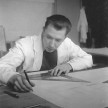 Wegner takes a two-and-a-half month’s cabinet making course at Teknologisk Institut and, subsequently, applies for admittance at the School of Arts and Crafts.
Wegner takes a two-and-a-half month’s cabinet making course at Teknologisk Institut and, subsequently, applies for admittance at the School of Arts and Crafts.
1936
 HJW and Børge Mogensen plus two unidentified students. School of Art and Design circa 1937
HJW and Børge Mogensen plus two unidentified students. School of Art and Design circa 1937
Wegner enters the School of Arts and Crafts’, specialising in cabinet making. Here he meets and befriends fellow Jutlander, Børge Mogensen.
1938
 Wegner has his debut at Snedkerlaugets exhibition with dining table and chairs, and armchairs drawn for Master of Crafts, Ove Lander.
Wegner has his debut at Snedkerlaugets exhibition with dining table and chairs, and armchairs drawn for Master of Crafts, Ove Lander.
Architects, Arne Jacobsen and Erik Møller set up office in Århus to start the project of building the new town hall. On recommendation of his teacher, O. Mølgaard Nielsen, Wegner is hired to draw furniture for the building and is, therefore, granted one year’s leave from his studies. However, his first assignment was to draw the furniture for Nyborg Public Library for Erik Møller and Flemming Lassen. For a period, he is also sent to Nyborg to oversee the building process.
1939
 Dining room furniture for Snedkerlaugets exhibition for Master of Crafts, P. Nielsen. Even before finishing his assignment in Nyborg, Wegner is called to Århus for the town hall project.
Dining room furniture for Snedkerlaugets exhibition for Master of Crafts, P. Nielsen. Even before finishing his assignment in Nyborg, Wegner is called to Århus for the town hall project.
1939-42
 Furniture for Århus Town Hall is completed (produced by I.C.A Nielsen and Planmøbel). ” I designed all the furnishings for the CIty Hall, naturally I discussed it with Erik Møller, who was responsible for the hall and may have had some ideas. When there are only three men and a boss, everyone works together very closely. Of course, it’s Erik Møller and Arne Jacobsen’s furniture in the City Hall. I learnt a lot from being there”. ref Just One Good Chair Christian Holmsted Olesen p.39.
Furniture for Århus Town Hall is completed (produced by I.C.A Nielsen and Planmøbel). ” I designed all the furnishings for the CIty Hall, naturally I discussed it with Erik Møller, who was responsible for the hall and may have had some ideas. When there are only three men and a boss, everyone works together very closely. Of course, it’s Erik Møller and Arne Jacobsen’s furniture in the City Hall. I learnt a lot from being there”. ref Just One Good Chair Christian Holmsted Olesen p.39.
Alongside his work in the drawing room, Wegner starts cooperation with Master Woodcutter, Michael Laursen in Århus and Johannes Hansens Møbelsnedkeri in Copenhagen.
1940
 Rocking chair for Michael Laursen. The rocking chair is the first Wegner model to go into mass production.
Rocking chair for Michael Laursen. The rocking chair is the first Wegner model to go into mass production.
1941
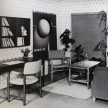 Wegner collaborates with cabinet maker Johannes Hansen , the son of a former Danish Minister for Agriculture, for the first time. They exhibit a cabinet and dining set plus a living room group with sofa upholstered in green fabric. It is the first in an unbroken row of 26 consecutive appearances at Snedkerlauget’s between the designer and cabinet maker.
Wegner collaborates with cabinet maker Johannes Hansen , the son of a former Danish Minister for Agriculture, for the first time. They exhibit a cabinet and dining set plus a living room group with sofa upholstered in green fabric. It is the first in an unbroken row of 26 consecutive appearances at Snedkerlauget’s between the designer and cabinet maker.
Wegner signs with Planmøbel for three series of office furniture.
The office furniture for Planmøbel and Wegner’s assignment for Jacobsen and Møller melt together in that the furniture for Planmøbel in installed in Århus Rådhus albeit with some slight modifications.
Wegner establishes his own drawing office in Århus as a self employed designer.
1942
 Johannes Hansen and Wegner exhibit living room furniture in Cuban mahogany at the annual Cabinet Makers Exhibition.
Johannes Hansen and Wegner exhibit living room furniture in Cuban mahogany at the annual Cabinet Makers Exhibition.
1943
 Wegner exhibits furniture in walnut at the annual Cabinet Makers Exhibition including a sofa in a striking green striped fabric.
Wegner exhibits furniture in walnut at the annual Cabinet Makers Exhibition including a sofa in a striking green striped fabric.
 Fritz Hansen asks Wegner for suggestions for their bent-wood-production. The results are The Chinese Chairs of which two go into production (FH 4283 and FH 1783 – later as PP 66 at PP Møbler). Wegner continues drawing for Fritz Hansen until the mid fifties.
Fritz Hansen asks Wegner for suggestions for their bent-wood-production. The results are The Chinese Chairs of which two go into production (FH 4283 and FH 1783 – later as PP 66 at PP Møbler). Wegner continues drawing for Fritz Hansen until the mid fifties.
 Drawing of his friend Børge Mogensen by Wegner while at the school of Arts and Crafts.
Drawing of his friend Børge Mogensen by Wegner while at the school of Arts and Crafts.
Børge Mogensen establishes contact between Wegner and FDB (equivalent to the Co-Operative movement). Mogensen had been appointed by the FDB in 1939 to help create an affordable range of functional modern furniture and popularise the cause of modernism.
Wegner gains membership of Akademisk Arkitektforbund (MAA) and Kunstersamfundet.
1944
 Wegner’s daughters Marianne aged 41/2and Eva aged 1 photographed with ‘Peter’s Table and Chair’ for an article on the Wegner family in the Politiken newspaper. The feature appeared in 1951 following the award to Wegner of the Lunning Prize.
Wegner’s daughters Marianne aged 41/2and Eva aged 1 photographed with ‘Peter’s Table and Chair’ for an article on the Wegner family in the Politiken newspaper. The feature appeared in 1951 following the award to Wegner of the Lunning Prize.
Wegner designs the children’s furniture ‘Peter’s Chair and Table’ and the rocking chair, J16. Both enter production at Tarm Stole og Møbelfabrik, owned by FDB.
 Wegner originally designed the table and chair to mark the chistening of ‘Peter’, the son of his friend Børge Mogensen. Due to the shortage of available materials at the time Wegner made the gift one Sunday morning from an old door with a construction that could be easily taken apart for shipping and rebuilt by a child. Today the Children’s furniture is produced by Carl Hansen and Son and the J16 Rocking Chair by Fredericia Furniture.
Wegner originally designed the table and chair to mark the chistening of ‘Peter’, the son of his friend Børge Mogensen. Due to the shortage of available materials at the time Wegner made the gift one Sunday morning from an old door with a construction that could be easily taken apart for shipping and rebuilt by a child. Today the Children’s furniture is produced by Carl Hansen and Son and the J16 Rocking Chair by Fredericia Furniture.
The Fish Cabinet
 HJW-Sketch of the intarsia work on the left hand door of the Fish Cabinet.
HJW-Sketch of the intarsia work on the left hand door of the Fish Cabinet.
Wegner draws and completes the intarsia work on ‘The Fish Cabinet’ (JH). In terms of craftsmanship Wegner’s Fish Cabinet is perhaps the best demonstration of both his carpentry and artistic skills. It was designed for Johannes Hansen’s booth at the 1944 Cabinet Makers Guild Exhibition. On first viewing it is an extremely functional cabinet characteristic of the Klint school.
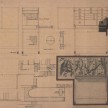 Wegner’s drawing of the complete cabinet for Johannes Hansen.
Wegner’s drawing of the complete cabinet for Johannes Hansen.
The interior is extravagently ornamented with a design inspired by the organic life observed in boyhood along the banks of the Vidå in Tønder. The internal surfaces, doors and drawer fronts depict an underwater world of fish and plant life.
 The finished cabinet showing the intricate inlay of the interior.
The finished cabinet showing the intricate inlay of the interior.
The interior design of the Fish Cabinet can be seen as a teasing response by Wegner contradictary to the Karre Klint school of functional design which banished superfluous decoration. However, Wegner could not persuade Johannes Hansen to produce the cabinet, the interior of which required over 3,000 pieces of individually cut intarsia work. The marquetry inlayer contracted for the work said it was too demanding and impossible to produce.
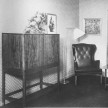
 The Johannes Hansen booth at the annual Cabinet Makers Guild Exhibition, Copenhagen circa 1944.
The Johannes Hansen booth at the annual Cabinet Makers Guild Exhibition, Copenhagen circa 1944.
The cabinet was completed by Wegner himself cutting and inlaying each piece over a three week period in his apartement. Wegner later recalled. I said, “Damn, I’ll just make it myself. So I sharpened a pocket knife given to me by Damgaard Jensen – it may have been more of a craftsman effort than an artistic one, but it was fun to make”. Master craftsman Ejnar Pederesen, a central figure in 20th century Danish furniture making said of Wegner craftsmanship “I know no fellow whose ability equals Wegner’s. I’ve never met anyone with similar skills”.ref Just One Good Chair, Christian Holmsted Olessen. p 222,223.
1945-46

 Wegner and Børge Mogensen co-operate on designing for Snedkerlauget, The Cabinet Makers Guild annual exhibition.The two friends spent time at a holiday cottage and designed all of the furniture together. They agreed to split the rights to the designs and Mogensen took those for the Spoke Backed Sofa and Wegner the matching easy chair.
Wegner and Børge Mogensen co-operate on designing for Snedkerlauget, The Cabinet Makers Guild annual exhibition.The two friends spent time at a holiday cottage and designed all of the furniture together. They agreed to split the rights to the designs and Mogensen took those for the Spoke Backed Sofa and Wegner the matching easy chair.
1946
Wegner and Børge Mogensen win first prize in Magasin du Nord’s competition on practical and up-to-date hotel furniture.
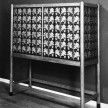 For the second year in succession Wegner collaborates with his friend Børge Mogensenin designing the furniture for the Johannes Hansen stand at the annual Cabinet Makers Exhibition. Weighers contribution includes a highly decorative cabinet with an acorn and oak leaf motif rendered in intarsia on the front and sides.
For the second year in succession Wegner collaborates with his friend Børge Mogensenin designing the furniture for the Johannes Hansen stand at the annual Cabinet Makers Exhibition. Weighers contribution includes a highly decorative cabinet with an acorn and oak leaf motif rendered in intarsia on the front and sides.
 HJW and Master cabinet maker Johannes Hansen circa 1960
HJW and Master cabinet maker Johannes Hansen circa 1960
Wegner moves to Copenhagen closer to Johannes Hansen’s workshop and the creative environment where he feels most inspired.
 Left to right HJW- Poul Hansen-Niels Thompsen circa 1975
Left to right HJW- Poul Hansen-Niels Thompsen circa 1975
Due to the fact that Wegner moves to Copenhagen his cooperation with Johannes Hansen gets closer. Johannes Hansen allows Wegner to make whatever furniture he likes at his workshop, and Wegner becomes close friends with the foreman, Niels Thomsen who starts working at the workshop in 1947. ‘The Peacock Chair’ from 1947 is the first of many unique pieces of furniture.
1946-48
Furniture for the ship Venus for Palle Suensons Tegnestue.
1946-51
Wegner becomes a teacher the School for Arts and Crafts and is also employed by Professor, Palle Suenson’s drawing office.
1947

 Wegner shows the Peacock Chair at the annual Cabinet Makers Exhibition. Although described at the time as the best stand that year, the large Windsor inspired chair was also described as being ‘one of the more exotic contributions. However, the chair rapidly gains International attention in subsequent years and is a turning point in Wegner’s establishing his own style.
Wegner shows the Peacock Chair at the annual Cabinet Makers Exhibition. Although described at the time as the best stand that year, the large Windsor inspired chair was also described as being ‘one of the more exotic contributions. However, the chair rapidly gains International attention in subsequent years and is a turning point in Wegner’s establishing his own style.
1948
 Johannes Hansen stand at the annual Cabinet Makers Exhibition features a living room with furniture in cherry and a drop leaf dining table in teak with chairs and matching cabinet.
Johannes Hansen stand at the annual Cabinet Makers Exhibition features a living room with furniture in cherry and a drop leaf dining table in teak with chairs and matching cabinet.
 Shell Chairs in moulded plywood for MoMAs competition on low-cost furniture. This simple design of minimum components could be stacked for export. The armrests are part of the moulded shell giving the design a sculptural three dimensional quality. The concept was extremely advanced for the available technology at the time of the exhibition although in 1989 Wegner built a full scale model to demonstrate its viability.
Shell Chairs in moulded plywood for MoMAs competition on low-cost furniture. This simple design of minimum components could be stacked for export. The armrests are part of the moulded shell giving the design a sculptural three dimensional quality. The concept was extremely advanced for the available technology at the time of the exhibition although in 1989 Wegner built a full scale model to demonstrate its viability.

 Advertisement for the Venus Chair at Oxford Circus on the London Underground May 2014.
Advertisement for the Venus Chair at Oxford Circus on the London Underground May 2014.
The FH1936 Chair, table FH1937, and sofa FH1935 with two dimensional moulded shells were the first of Wegner’s experiments using the then new technology of laminated wood to be produced. Fritz Hansen manufacture the series up to around 1953. In 2014 to mark the Centenary of Wegner’s birth Getama and the British retailer John Lewis re-introduce the series as the Venus Chair and Venus Bench in celebration of Wegner’s centenary and the retailers 150 th anniversary.
1949
 ‘The Round One’/’The Chair’ with woven cane seat, the folding chair, and the three-shells shell chair (all JH). ‘The Y-Chair’ or Wishbone chair are designed.
‘The Round One’/’The Chair’ with woven cane seat, the folding chair, and the three-shells shell chair (all JH). ‘The Y-Chair’ or Wishbone chair are designed.


 Wegner gets his national first break-through with his furniture at the Snedkerlauget’s exhibition. Amongst other designs Johannes Hansen exhibits The Round Chair and The Folding Chair which gain national attention.
Wegner gets his national first break-through with his furniture at the Snedkerlauget’s exhibition. Amongst other designs Johannes Hansen exhibits The Round Chair and The Folding Chair which gain national attention.
 Inga Wegner at home sitting in the only Tripartite Shell Chair ever produced. It remained in the lounge of the Wegner house in Gentofte.
Inga Wegner at home sitting in the only Tripartite Shell Chair ever produced. It remained in the lounge of the Wegner house in Gentofte.
The Tripartite Shell Chair. A very open airy chair with the three shells appearing to float above the frame. The bent laminated frame is in fact in two parts, one fixing the shells, the other tying together the structure.  The two frames join where their combined thickness is required to provide most strength and support. The chair demonstrates Wegner’s mastering of the laminating technique.
The two frames join where their combined thickness is required to provide most strength and support. The chair demonstrates Wegner’s mastering of the laminating technique.
Wegner is the exhibition architect for Foreningen af Dansk Kunsthåndværk.
Wegner initiates co-operation with Carl Hansen and Son.
1950
 SAESCO is founded by Elvind Kold Christensen. Christensen was an entrepreneur and salesman who dissatisfied with the quality of the furniture he was selling was inspired on seeing the Round Chair the previous year and approached Wegner to work with him. He introduced the young designer to five furniture producers who could produce furniture designed for mass production without compromising the quality of the furniture. Together they formed SALESCO comprising of Carl Hansen & Son who produced chairs, Getama upholstered furniture with timber frames, the upholsterer A. P. Stolen, Ry Møbler makers of storage units and Andreas Tuck a manufacturer of tables.
SAESCO is founded by Elvind Kold Christensen. Christensen was an entrepreneur and salesman who dissatisfied with the quality of the furniture he was selling was inspired on seeing the Round Chair the previous year and approached Wegner to work with him. He introduced the young designer to five furniture producers who could produce furniture designed for mass production without compromising the quality of the furniture. Together they formed SALESCO comprising of Carl Hansen & Son who produced chairs, Getama upholstered furniture with timber frames, the upholsterer A. P. Stolen, Ry Møbler makers of storage units and Andreas Tuck a manufacturer of tables.
SALESCO played a pivitol role in promoting Wegner and Danish design to an international audience only sold Wegner designs throughout the 1950’s and 60’s. The co-operation began with Wegner designing precisely what the E. Kold Christiansen most wanted – a low cost beautifully designed dining/cafe chair – The Wishbone or Y Chair.
 The CH24 Wishbone chair enters production with Carl Hansen and Son. Although Wegner was never fully satisfied with the ergonomics of the chair it demonstrates his brilliance in designing furniture that was cheap to produce but beautifully conceived. Due to its design and suitability for for mass production it becomes the most commercially successful of all Wegner’s chairs and has remained the mainstay of Carl Hansen’s production for over six decades.
The CH24 Wishbone chair enters production with Carl Hansen and Son. Although Wegner was never fully satisfied with the ergonomics of the chair it demonstrates his brilliance in designing furniture that was cheap to produce but beautifully conceived. Due to its design and suitability for for mass production it becomes the most commercially successful of all Wegner’s chairs and has remained the mainstay of Carl Hansen’s production for over six decades.
 Furniture designed by Finn Juhl, Børge Mogensen, and Wegner are chosen for the American magazine Interiors who publishes an article in february 1950 and feature the Round Chair on the cover, catapulting Wegner into international fame and sparking a profitable export market. It became known simply as, The Chair and began making high profile appearances like the televised 1961 presidential debates between Nixon and Kennedy. Of the design Wegner said, “many foreigners have asked me how we made the Danish style. And I’ve answered that it…was rather a continuous process of purification, and for me of simplification, to cut down to the simplest possible elements of four legs, a seat and combined top rail and arm rest.”
Furniture designed by Finn Juhl, Børge Mogensen, and Wegner are chosen for the American magazine Interiors who publishes an article in february 1950 and feature the Round Chair on the cover, catapulting Wegner into international fame and sparking a profitable export market. It became known simply as, The Chair and began making high profile appearances like the televised 1961 presidential debates between Nixon and Kennedy. Of the design Wegner said, “many foreigners have asked me how we made the Danish style. And I’ve answered that it…was rather a continuous process of purification, and for me of simplification, to cut down to the simplest possible elements of four legs, a seat and combined top rail and arm rest.”
Wegner starts co-operation with a further four producers, each with their own specialty: Andreas Tuck (tables), Getama (Furniture with loose cushions), Ry Møbler (cabinets and closets), and A.P. Stolen (upholstery). Simultaniously he designs furniture for Carl Hansen.


 The designs for Carl Hansen include the chairs CH22, CH23, and CH25.
The designs for Carl Hansen include the chairs CH22, CH23, and CH25.
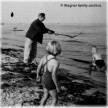
 ‘The Flag Halyard Chair’, inspired by digging in the sand when on holiday at the seaside with his children and is designed for Getama. PP Møbler assume the production of the chair as model pp225 in 2002.
‘The Flag Halyard Chair’, inspired by digging in the sand when on holiday at the seaside with his children and is designed for Getama. PP Møbler assume the production of the chair as model pp225 in 2002.
 Johannes Hansen’s stand at the 1950 annual Cabinet Maker Exhibition is clearly indicative of Wegner’s growing confidence.
Johannes Hansen’s stand at the 1950 annual Cabinet Maker Exhibition is clearly indicative of Wegner’s growing confidence.

 The Round Chairs are shown with upholstered seats and with the re-worked finger joints expressing the beauty of the timber.
The Round Chairs are shown with upholstered seats and with the re-worked finger joints expressing the beauty of the timber.

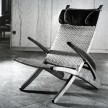 The collapsable Dolphin Chairs are two of the finest examples of Wegner’s understanding of the possibilities of wood.
The collapsable Dolphin Chairs are two of the finest examples of Wegner’s understanding of the possibilities of wood.
‘The Round Chair’ (pp503) is selected by both audience and a professional board as best design on the exhibition ‘Good Design’ in USA.
Wegner is awarded the Grand Prix at the Milano Triennial.
1951
 Wegner and Finnish Tapio Wirkkala are the first to be awarded ‘Lunningsprisen’. The Lunning Prize was instituted by the Frederick Lunning owner of the New York agency for Georg Jensen an was awarded annually to two eminent Scandinavian designers between 1951 to 1970. The recipients were selected by a group of peers from Denmark, Sweden, Norway and Finland.
Wegner and Finnish Tapio Wirkkala are the first to be awarded ‘Lunningsprisen’. The Lunning Prize was instituted by the Frederick Lunning owner of the New York agency for Georg Jensen an was awarded annually to two eminent Scandinavian designers between 1951 to 1970. The recipients were selected by a group of peers from Denmark, Sweden, Norway and Finland.
 The Teddy Bear Chair’ (AB), ‘The Dolphin Chair’ (JH) and CH28.
The Teddy Bear Chair’ (AB), ‘The Dolphin Chair’ (JH) and CH28.
 Johannes Hansen stand at the annual Cabinet Makers Exhibition 1951.
Johannes Hansen stand at the annual Cabinet Makers Exhibition 1951.
1952


 Placed around a circular table at the annual Cabinet Makers Exhibition Wegner unveils ‘The Cow Horn Chair’ Designed for Johannes Hansen. This was the first occasion whe Wegner choose to make the construction of the chair a decorative feature emphasising the beauty of the wood. Suspended above the table is a conical pendent light fitted with a convenient pull handle and rise and fall mechanism a forerunner of the later successful Wegner Pendent.
Placed around a circular table at the annual Cabinet Makers Exhibition Wegner unveils ‘The Cow Horn Chair’ Designed for Johannes Hansen. This was the first occasion whe Wegner choose to make the construction of the chair a decorative feature emphasising the beauty of the wood. Suspended above the table is a conical pendent light fitted with a convenient pull handle and rise and fall mechanism a forerunner of the later successful Wegner Pendent.

 From the photo montage ‘in Politiken, December 1951.
From the photo montage ‘in Politiken, December 1951.
The Sawhorse Chair’ is launched by Carl Hansen & Son. The chair first appeared in a portrait on Wegner in December 1951 in the newspaper, Politiken. Wegner’s housemaid is pictured sitting in the Chair. The text reads: ‘By the time Hans J. Wegner sends a chair out into the world, he has tested it thoroughly and for a long time. Wegner was pleased with how comfortable the chair was, plus the fact that it was light enough to be handled easily by a housewife.
Cooperation with C. M. Madsen’s factories is initiated due to an increasing demand for light Wegner chairs.
Wegner becomes supervisor of the teaching at the School for Arts and Crafts.

 The Lunning Prize affords Wegner and his wife, Inga, the opportunity to take a three-month study trip to USA and Mexico.Wegner takes time to visit modern advanced factories and is offered the possibility of having his carpentry-based furniture produced by a high-tech company, but says no. Later recalling the offer he said ” I wasn’t happy about it. I felt that Danish craftsmen should do the work. It was not designed for them. Not for big American factories. They said: We can do the same on machines…I didn’t want to do it”.
The Lunning Prize affords Wegner and his wife, Inga, the opportunity to take a three-month study trip to USA and Mexico.Wegner takes time to visit modern advanced factories and is offered the possibility of having his carpentry-based furniture produced by a high-tech company, but says no. Later recalling the offer he said ” I wasn’t happy about it. I felt that Danish craftsmen should do the work. It was not designed for them. Not for big American factories. They said: We can do the same on machines…I didn’t want to do it”.
ref interview with Henrik Steen Møller, Stolemageren Hans J. Wegner, a film by Lise Roos 1992.
1953

 The Valet Chair and the Upholstered Peacock are both shown by Wegner and Johannes Hansen for he first time at the 1953 Cabinet Makers Exhibition.
The Valet Chair and the Upholstered Peacock are both shown by Wegner and Johannes Hansen for he first time at the 1953 Cabinet Makers Exhibition.
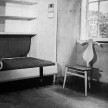
 The Valet Chair, designed in 1953, had elements for hanging up or storing each piece of a Mans Suit. The carved backrest is used as a coat hanger, trousers hung on a rail at the edge of the seat and the contents of ones pockets in storage space underneath the seat.
The Valet Chair, designed in 1953, had elements for hanging up or storing each piece of a Mans Suit. The carved backrest is used as a coat hanger, trousers hung on a rail at the edge of the seat and the contents of ones pockets in storage space underneath the seat.
Wegner receives honorary diploma and gold medal at the Milano Triennale.
 Wegner designs the GE290 series of armchairs and sofas for Getama. Nicknamed the Plank chairs by consumers because of the broad arms convenient for resting a cup or glass on. The chairs are an evolution of the earlier CH25 easy chair offering greater comfort for prolonged sitting.
Wegner designs the GE290 series of armchairs and sofas for Getama. Nicknamed the Plank chairs by consumers because of the broad arms convenient for resting a cup or glass on. The chairs are an evolution of the earlier CH25 easy chair offering greater comfort for prolonged sitting.
1954
The Cabinet Makers Exhibition 1954, Featuring the adjustable Tub Chair and Architects Desk both of which were re-introduced exactly 60 years later by PP Møbler to mark the centenary of Wegner’s birth.
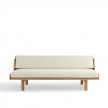 Inspired by the increase in student hostels Wegner designs his series of daybeds for Getama.
Inspired by the increase in student hostels Wegner designs his series of daybeds for Getama.
1955
 Wegner and Professor Eigil Sørensen discuss ergonomics. Circa 1955
Wegner and Professor Eigil Sørensen discuss ergonomics. Circa 1955
Wegner draws the office swivel chair (JH), which is inspired by Professor, Eigil Snorrasons effort to make designers focus on ergonomics. This can be seen in the support for the lower back support based on Wegner’s detailed study of X rays.

 The Swivel Chair is exhibited for the first time on the Johannes Hansen stand at the annual Cabinet Makers Exhibition.
The Swivel Chair is exhibited for the first time on the Johannes Hansen stand at the annual Cabinet Makers Exhibition.
1956
 Wegner receives the Eckersberg medal. (originally the Akademiets Aarsmedaille or Annual Academy Medal) is an annual award of the Royal Danish Academy of Fine Arts, named after the Danish painter Christopher Wilhelm Eckersberg.
Wegner receives the Eckersberg medal. (originally the Akademiets Aarsmedaille or Annual Academy Medal) is an annual award of the Royal Danish Academy of Fine Arts, named after the Danish painter Christopher Wilhelm Eckersberg.
Recipient of the Dansk Købestævne’s annual medal.
 Stackable chair for Fritz Hansen with an experimental frame of laminated beech. It was not put into production due to the relatively high cost of manufacture. In 2004 it was prototyped by Carl Hansen and Son for a project in Madrid and entered into production a year later.
Stackable chair for Fritz Hansen with an experimental frame of laminated beech. It was not put into production due to the relatively high cost of manufacture. In 2004 it was prototyped by Carl Hansen and Son for a project in Madrid and entered into production a year later.

 Wegner’s contribution to the annual Cabinet Makers Exhibition is a pair of beautifully executed reclining chairs, one shorter than the other echoing the proportions of the Dolphin chairs exhibited in 1950. Both chairs are fitted with wheels to help manoeuvre them around the room and are upholstered with woven straps making them a comfortable sit.
Wegner’s contribution to the annual Cabinet Makers Exhibition is a pair of beautifully executed reclining chairs, one shorter than the other echoing the proportions of the Dolphin chairs exhibited in 1950. Both chairs are fitted with wheels to help manoeuvre them around the room and are upholstered with woven straps making them a comfortable sit.
1957
Wegner receives the silver medal at the Milano Triennale.
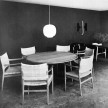
 Johannes Hansen unveils a refined armchair in oak with a woven cane seat and back. Wegner also shows his Roman Chair sometimes referred to as the Buffalo Chair as an accompanyment to an The Architects Desk.
Johannes Hansen unveils a refined armchair in oak with a woven cane seat and back. Wegner also shows his Roman Chair sometimes referred to as the Buffalo Chair as an accompanyment to an The Architects Desk.
1958
 The interior furnishing by Wegner of a committee room. UNESCO Paris 1958.
The interior furnishing by Wegner of a committee room. UNESCO Paris 1958.
Wegner designs furniture including conference tables for the UNESCO building in Paris designed by Marcel Breuer, Pier Luigi Nervi and Bernard Zehrfuss.
Wegner receives Dansk Snedkerlaugs annual award.
Wegner receives Citation of Merit at the Pratt Institute in New York, USA.
 Wegner is awarded in Britain and becomes an honorary Royal Designer for Industry of the Royal Society of Arts, London.
Wegner is awarded in Britain and becomes an honorary Royal Designer for Industry of the Royal Society of Arts, London.
1959
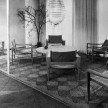

Taking the Safari Chair designed by his old teacher Karre Klint as a reference Wegner designed a low Easy Chair for display at the annual Snedkerlaugets exhibition. The chair frame in oak is shown in a red lacquer with upholstery in woven cane and saddle leather.The angle of the back adjusts on a pivot which is positioned low enough to ensure the back is correctly supported.
Retrospective Exhibition George Jensen’s New York.


 Frederick Lunning who awarded the Lunning Prize arranged a retrospective exhibition of Wegner’s designs in the New York showrooms of Georg Jensen. The US press reported that the exhibition as a triumph. Wegner always worked on all his exhibition builds himself. ref Just One Good Chair Christian Holmsted Olessen p 67.
Frederick Lunning who awarded the Lunning Prize arranged a retrospective exhibition of Wegner’s designs in the New York showrooms of Georg Jensen. The US press reported that the exhibition as a triumph. Wegner always worked on all his exhibition builds himself. ref Just One Good Chair Christian Holmsted Olessen p 67.

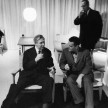

From left to right during at the opening of the New York Exhibition. Inga Wegner, Frederik Lunning, HJW In conversation with Charles Eames In conversation with PhilipMorris
Wegner draws the plans for building his own holiday home at Hald Strand on Northern Sealand.
1960
 The iconic image of John F. Kennedy sitting in Wegner’s Round Chair (pp503) NBC presidential debate 1960.
The iconic image of John F. Kennedy sitting in Wegner’s Round Chair (pp503) NBC presidential debate 1960.
John F. Kennedy faces Richard Nixon in the first presidential election debate to be televised on NBC. They sit on “The Chair”. The debate proved favourable to Kennedy amongst television viewers and pivotal in the forthcoming election.
 The Ox Chair (AP) Wegner had an Ox Chair in his own living room. He was photographed in it a number of times, which suggests he was particularly fond of the chair, not least of all because one can sit in so many ways. The highly conspicuous headrest are reminisent of the horns of an ox but the cylindrical “sausage shaped” bolster gained the chair the nickname of the ‘Sausage Chair’ in Denmark.
The Ox Chair (AP) Wegner had an Ox Chair in his own living room. He was photographed in it a number of times, which suggests he was particularly fond of the chair, not least of all because one can sit in so many ways. The highly conspicuous headrest are reminisent of the horns of an ox but the cylindrical “sausage shaped” bolster gained the chair the nickname of the ‘Sausage Chair’ in Denmark.
Wegner receives the International Design Award byt the American Institute of Decorators for Furniture Design.
 Wegner receives the Swedish Prins Eugen medal. The medal was founded to commemorate the eightieth birthday of the Swedish prince in 1945 and is awarded for outstanding artistic achievement.
Wegner receives the Swedish Prins Eugen medal. The medal was founded to commemorate the eightieth birthday of the Swedish prince in 1945 and is awarded for outstanding artistic achievement.

 Wegner and Johannes Hansen show a desk and circular conference table in oak with matching conference chairs (JH 513) at the annual Cabinet Makers Exhibition.
Wegner and Johannes Hansen show a desk and circular conference table in oak with matching conference chairs (JH 513) at the annual Cabinet Makers Exhibition.
1961
 Wegner exhibits a circular table and storage unit in teak together with the Bull Chair on the 1961 Johannes Hansen contribution to the annual Cabinet Makers Exhibition. Suspended above the table the pendent complete with a handle and rise and fall mechanism Wegner first exhibited in 1952. On that occasion together with the Cowhorn chair the precursor to the more masculine Bull.
Wegner exhibits a circular table and storage unit in teak together with the Bull Chair on the 1961 Johannes Hansen contribution to the annual Cabinet Makers Exhibition. Suspended above the table the pendent complete with a handle and rise and fall mechanism Wegner first exhibited in 1952. On that occasion together with the Cowhorn chair the precursor to the more masculine Bull.
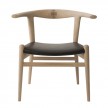 The Bull Chair. Wegner drew several variations on the Bull chair some with some without horns. It is a fine example of the line Wegner could masterfully walk between elegance and playfulness. “We must take care,” he once said, “that everything doesn’t get so dreadfully serious. We must play – but we must play seriously.” In his later years he continued to design chairs and has also worked with lighting, such as the Pole lamp created in 1976 with his daughter Marianne. A true craftsman, Wegner stated that, “the chair does not exist. The good chair is a task one is never completely done with.”
The Bull Chair. Wegner drew several variations on the Bull chair some with some without horns. It is a fine example of the line Wegner could masterfully walk between elegance and playfulness. “We must take care,” he once said, “that everything doesn’t get so dreadfully serious. We must play – but we must play seriously.” In his later years he continued to design chairs and has also worked with lighting, such as the Pole lamp created in 1976 with his daughter Marianne. A true craftsman, Wegner stated that, “the chair does not exist. The good chair is a task one is never completely done with.”
1962-65
 Wegner builds own house in Gentofte in cooperation with architects, Arne Karlsen and Allan Jessen.
Wegner builds own house in Gentofte in cooperation with architects, Arne Karlsen and Allan Jessen.
1962


 Johannes Hansen shows a new Wegner Folding Chair and leather upholstered JH 513 Conference chairs around a large circular table. Wegner highlighted the teak surface of the table by suspending a circular ring of lights of his own design above it. In addition Wegner presented a beautifully refined version of his rise and fall pendent with curved sides.
Johannes Hansen shows a new Wegner Folding Chair and leather upholstered JH 513 Conference chairs around a large circular table. Wegner highlighted the teak surface of the table by suspending a circular ring of lights of his own design above it. In addition Wegner presented a beautifully refined version of his rise and fall pendent with curved sides.
1963

 The three-legged shell chair (JH)is unveiled at the Cabinet Makers Guild annual exhibition. A development of his ideas for the 1948 Museum of Modern Art completion for Low Cost Furniture the Three Legged Chairs were praised for their technical competance but criticised for their bulk and cost of production. Johannes Hansen produced a dozen chairs in 1989 to mark Wegner’s 75 th birthday. It was not until 1998 that it was put into full scale prodction by Carl Hansen and Son. The pendent LO37 is suspended above the low table around which the chairs are arranged.
The three-legged shell chair (JH)is unveiled at the Cabinet Makers Guild annual exhibition. A development of his ideas for the 1948 Museum of Modern Art completion for Low Cost Furniture the Three Legged Chairs were praised for their technical competance but criticised for their bulk and cost of production. Johannes Hansen produced a dozen chairs in 1989 to mark Wegner’s 75 th birthday. It was not until 1998 that it was put into full scale prodction by Carl Hansen and Son. The pendent LO37 is suspended above the low table around which the chairs are arranged.
1964
Furniture for Tuborg in Hellerup (JH).


 Wegner is awarded Københavns Snedkerlaugs annual award. He exhibits a range of outdoor furniture building on the folding chair displayed the previous year.
Wegner is awarded Københavns Snedkerlaugs annual award. He exhibits a range of outdoor furniture building on the folding chair displayed the previous year.
1965

 Wegner and Johannes Hansen exhibit a range of office furniture and chairs at the Cabinet Makers Guild exhibition including the ‘Little Steel Chair’ he has decided to use in his own home in Gentofte.
Wegner and Johannes Hansen exhibit a range of office furniture and chairs at the Cabinet Makers Guild exhibition including the ‘Little Steel Chair’ he has decided to use in his own home in Gentofte.

 The chair is described as an ‘exceptionally elegant little chair’. The set of four illustrated remained in Wegner’s dinning room for the next 42 years up to the designers death in 2007.
The chair is described as an ‘exceptionally elegant little chair’. The set of four illustrated remained in Wegner’s dinning room for the next 42 years up to the designers death in 2007.
 CH44 Easy Chair for Carl Hansen & Son
CH44 Easy Chair for Carl Hansen & Son
1966

 The Snedkerlauget’s exhibitions end. Wegner’s final exhibits together Johannes Hansen includes a magnificent Boat Shaped Table JH713 together with JH 513 Conference Chairs and a surprisingly comfortable folding chair in canvas and tubular steel that in spite of its unpretentious appearance is extremely comfortable.
The Snedkerlauget’s exhibitions end. Wegner’s final exhibits together Johannes Hansen includes a magnificent Boat Shaped Table JH713 together with JH 513 Conference Chairs and a surprisingly comfortable folding chair in canvas and tubular steel that in spite of its unpretentious appearance is extremely comfortable.
Wegner has contributed to the Cabinet Makers Guild Exhibitions every year apart from 1940 since 1938. He won 24 prizes in the competitions associated with the event and around half the furniture he exhibited went into production.
Wegner receives the International Design Award from The American Institute of Interior Designs, New York, USA.
Wegner becomes a member of IDD, Danish Designers (today MDD).
1967
 Wegner returns to the theme of the Rocking Chair and designs a version for Getama which can be assembled and taken apart at will (GE673). The Chair is showcased together with other furniture especially designed for the company.
Wegner returns to the theme of the Rocking Chair and designs a version for Getama which can be assembled and taken apart at will (GE673). The Chair is showcased together with other furniture especially designed for the company.

 The new collection for Getama includes the Hammock Chair. Wegner had experimented with laminated wood supporting the body with a web of woven flag halyard. A technique he had previously employed in his 1958 Web Chairs, (PP129). The Hammock Chair was relaunched in 2014 by PP Møbler as PP 135. A little more than six months later, in January 1968, PP135 helped Wegner on his way to winning the American International Design Award for his collective contribution to furniture design.
The new collection for Getama includes the Hammock Chair. Wegner had experimented with laminated wood supporting the body with a web of woven flag halyard. A technique he had previously employed in his 1958 Web Chairs, (PP129). The Hammock Chair was relaunched in 2014 by PP Møbler as PP 135. A little more than six months later, in January 1968, PP135 helped Wegner on his way to winning the American International Design Award for his collective contribution to furniture design.
1968
 E. K. Christiansen leaves SALESCO to work with Poul Kjærholm and the new management decides to promote the work of other designers along side that of Wegner. This meant that the close hands-on collaboration that gave Wegner the control over the quality of his furniture was no longer possible and he stopped designing for the firm. However, Getama one of the most successful partners in the group wished to continue their partnership . Together they had already successfully supplied furniture for large residence halls and Wegner agreed to work closely with Getama on the interior design of this type.
E. K. Christiansen leaves SALESCO to work with Poul Kjærholm and the new management decides to promote the work of other designers along side that of Wegner. This meant that the close hands-on collaboration that gave Wegner the control over the quality of his furniture was no longer possible and he stopped designing for the firm. However, Getama one of the most successful partners in the group wished to continue their partnership . Together they had already successfully supplied furniture for large residence halls and Wegner agreed to work closely with Getama on the interior design of this type.

 Exhibition by Johannes Hansen saw the launch of the Web Chair. The pendent light was also designed by Wegner.
Exhibition by Johannes Hansen saw the launch of the Web Chair. The pendent light was also designed by Wegner.
 Wegner designs a range of college furniture for Getama for several large projects including student resedencies for Kampsax and Ostenfeld.
Wegner designs a range of college furniture for Getama for several large projects including student resedencies for Kampsax and Ostenfeld.
Wegner loosens his ties with JH, but is welcomed at another workshop, namely PP Møbler, who has produced wooden frames for AP Stolen’s Wegner furniture since 1953.
 Wegner starts drawing for PP Møbler and, in the mid seventies, PP Møbler takes over a large part of Wegner’s table-collection from Andreas Tuck including the Cross Legged Table PP 85.
Wegner starts drawing for PP Møbler and, in the mid seventies, PP Møbler takes over a large part of Wegner’s table-collection from Andreas Tuck including the Cross Legged Table PP 85.
1969

 Wegner’s the first furniture for PP are pp201 and pp203.
Wegner’s the first furniture for PP are pp201 and pp203.
 The modular and linkable chair series GE 370 with their wide practical armrests is designed for Getama. Designed in two heights the individual chairs can be linked and arms aded or removed as required.
The modular and linkable chair series GE 370 with their wide practical armrests is designed for Getama. Designed in two heights the individual chairs can be linked and arms aded or removed as required.

 Wegner’s house wins him an award from Gentofte Kommune.
Wegner’s house wins him an award from Gentofte Kommune.
1970
 In designing the sofa group and arm chair JH 801 for Johannes Hansen, Wegner demonstrated his ability to work in flat steel sections supporting upholstery built around a frame in solid beech. The group was re launched in 2008 on the 100 th anniversary of Carl Hansen & Son.
In designing the sofa group and arm chair JH 801 for Johannes Hansen, Wegner demonstrated his ability to work in flat steel sections supporting upholstery built around a frame in solid beech. The group was re launched in 2008 on the 100 th anniversary of Carl Hansen & Son.
1971
Wegner is awarded Diploma di Collaborazione at the Milano Triennale.
1973
 Furniture and lamps for Hotel Scandinavia. The asymmetrical polycarbonate shade is designed so different diameter shades can be cut from the same moulding forming the basis for a range of table and floor lights.
Furniture and lamps for Hotel Scandinavia. The asymmetrical polycarbonate shade is designed so different diameter shades can be cut from the same moulding forming the basis for a range of table and floor lights.
The oil crises of October 1973 damaged Danish exports and initiated the decline of the countries furniture industry.
1974
Furniture for Herlev Hospital (Getama A/S).
 Wegner re-thinks his chair for Børge Mogensens spindle back Sofa).
Wegner re-thinks his chair for Børge Mogensens spindle back Sofa).
1975
Wegner draws furniture for Amagercentret’s theatre and cinemas (GE).
Student hostel furniture for Ashdown House at MIT, USA (GE+CMM).

 Wegner wins first prize in a competition concerning streetlamps for environments worthy of preservation. His daughter Marianne, who has worked at his studio since 1973, collaborates on the design. The lamp goes into production two years later after a few revisions.
Wegner wins first prize in a competition concerning streetlamps for environments worthy of preservation. His daughter Marianne, who has worked at his studio since 1973, collaborates on the design. The lamp goes into production two years later after a few revisions.
1976
 Butterfly Chair (GE460) The production drawing reveals that the chair’s design was finished in 1976, but production did not begin until the following year. It was exhibited the same year at the Furniture Fair in the Bella Centre in a red painted version upholstered as illustrated in a black and white striped fabric. Sales were slow, and it was not until Getama re-introduced the chair in the early 1990s that production really took off. In 2013 agreement was reached for the chair to be distributed in the UK by the John Lewis Partnership.
Butterfly Chair (GE460) The production drawing reveals that the chair’s design was finished in 1976, but production did not begin until the following year. It was exhibited the same year at the Furniture Fair in the Bella Centre in a red painted version upholstered as illustrated in a black and white striped fabric. Sales were slow, and it was not until Getama re-introduced the chair in the early 1990s that production really took off. In 2013 agreement was reached for the chair to be distributed in the UK by the John Lewis Partnership.
By the end of the 1970’s, Ry Møbler and A.P. Stolen cease trading. JH now takes over production rights for Wegner’s upholstered furniture.
1977
Conference tables for Vejle Amtsråd (JH).
Conference tables for Politiken (JH).
Wegner serves as member of Dansk Designråd from 1977-81.
1978
Furniture for Sønderjyllands Amtsråd (JH).
Konference table for Ishøj Byråd (JH).
1979
Lamps (LP) and conference tables (JH) for Industriens Hus.
Conference table for A. P. Møller (JH).
1980
 Awarding of the Møbeprisen . HJW- Culture Minister Lise Østergaard and PP Møbler Master Cabinet Maker Ejnar Pedersen
Awarding of the Møbeprisen . HJW- Culture Minister Lise Østergaard and PP Møbler Master Cabinet Maker Ejnar Pedersen
Awarded the Furniture Prize.
1981
Wegner draws a special chair for the Moa Museum in Japan (PP).
1982
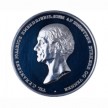 Wegner receives the C.F. Hansen medal, named after the architect C. F Hansen for his outstanding contribution to architecture. . The award established in 1830 is awarded by the Royal Danish Academy of fine arts it is the Academy’s highest distinction for architecture.
Wegner receives the C.F. Hansen medal, named after the architect C. F Hansen for his outstanding contribution to architecture. . The award established in 1830 is awarded by the Royal Danish Academy of fine arts it is the Academy’s highest distinction for architecture.
1983
Chairs and tables for the canteen and Sikker Hansen-salen at Politikens Hus (GE).
1984
Furniture for Mørdrup church in Espergærde (PP).
1985
Conference table Carlsberg in Hong Kong (JH).
Chairs for Salling Ungdomsskole (GE).
In the mid-eighties, Wegner participates in several SE exhibitions, which started in 1983 as a continuation of Snedkerlauget’s exhibitions.
1986
Conference table for Apotekerforeningen (PP)
 Wegner presents the Circle Chair to Queen Ingrid of Denmark at the Cabinet Makers Autumn Exhibition 1986.
Wegner presents the Circle Chair to Queen Ingrid of Denmark at the Cabinet Makers Autumn Exhibition 1986.
The Circle The Chair (PP130) draws a lot of attention at the exhibition.
Wegner receives Dansk Designråds design award.
1987
1988
 Stack and connectable chairs for Koldinghus Slot (JH).
Stack and connectable chairs for Koldinghus Slot (JH).
Wegner receives honorary grant from Nationalsbankens Jubilæumsfond.
Wegner receives grant from Ole Haslunds Kunstnerfond.
1989
 The Chinese Chair with upholstered seat. (PP56)
The Chinese Chair with upholstered seat. (PP56)
Production of the Ox Chair is re-introduced by Erik Jørgensen Møbelfabrik.
1990
 Conference chair PP240 (PP Møbler).
Conference chair PP240 (PP Møbler).
Wegner draws furniture for The Maersk McKinney Møller Centre for Continuing Education in Cambridge, UK (PP and GE).
 Conference table for IBM in Lyngby (PP Møbler).
Conference table for IBM in Lyngby (PP Møbler).
1991
 The Chair is depicted on the 350 kroner stamp part of a set of four celebrating Danish designers.
The Chair is depicted on the 350 kroner stamp part of a set of four celebrating Danish designers.
JH closes and PP takes over the production of many well-known Wegner designs.

 Furniture for KPMG in Copenhagen.
Furniture for KPMG in Copenhagen.
Fredericia Furniture takes over a number og Wegner models after JH. FF and Wegner have cooperated previously in the mid-seventies and this time, as well as last time, the cooperation only lasts a few years.
1992
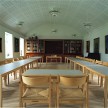 Wegner draws the ‘Rødding Chair’ (PP93/193) for Rødding Højskole’s 150’ieth birthday.
Wegner draws the ‘Rødding Chair’ (PP93/193) for Rødding Højskole’s 150’ieth birthday.
 Marianne Wegner SIT94 Exhibition in London to mark her father’s birthday.
Marianne Wegner SIT94 Exhibition in London to mark her father’s birthday.
Wegner stops drawing but continues as supervisor for his daughter, who has gradually taken over responsibility for Wegner’s furniture.
 The Møller Centre is completed in Cambridge with Wegner furniture specified throughout the building. It is the largest and most comprehensive interior by Hans Wegner in the UK. Marianne Wegner and Matthew Rhodes of The Cale Schiang Partnership co-ordinate the delivery and installation of furniture in the building.
The Møller Centre is completed in Cambridge with Wegner furniture specified throughout the building. It is the largest and most comprehensive interior by Hans Wegner in the UK. Marianne Wegner and Matthew Rhodes of The Cale Schiang Partnership co-ordinate the delivery and installation of furniture in the building.
1993
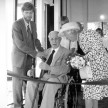 The water tower in Tønder is renovated and converted to house the Wegner museum. The museum’s collection consists of 36 of the designers chairs donated to the town by Hans and Inga Wegner.
The water tower in Tønder is renovated and converted to house the Wegner museum. The museum’s collection consists of 36 of the designers chairs donated to the town by Hans and Inga Wegner.
Opening ceremony 12 August 1995. Left to right: Ove Mogensen, Hans J. Wegner, Queen Ingrid of Denmark.
Wegner is made honorary member of Akademiet for de Skønne Kunster.
1995
Tønder’s Gift of Chairs. The Wegner Museum opens.
Wegner becomes honorary doctor at the Royal College of Art in London.
Wegner receives The 8th International Design Award in Osaka, Japan.
2004
Wegner celebrates his 90 th birthday. 130 of his models are still in production and the demand for his furniture is increasing.
2007
Wegner passes away leaving a remarkable legacy of design and craftsmanship for future generations to enjoy.
Obituaries.
The Telegraph Published 5 February 2007.
The Guardian Published 6 February 2007.
New York Times Published 5 February 2007.
Herald Tribune Published 7 February 2007.



















































































































































































































































